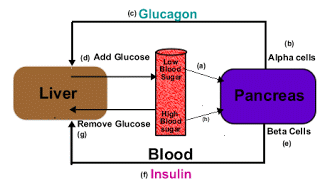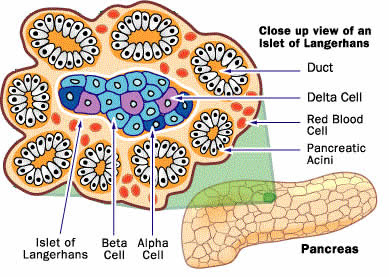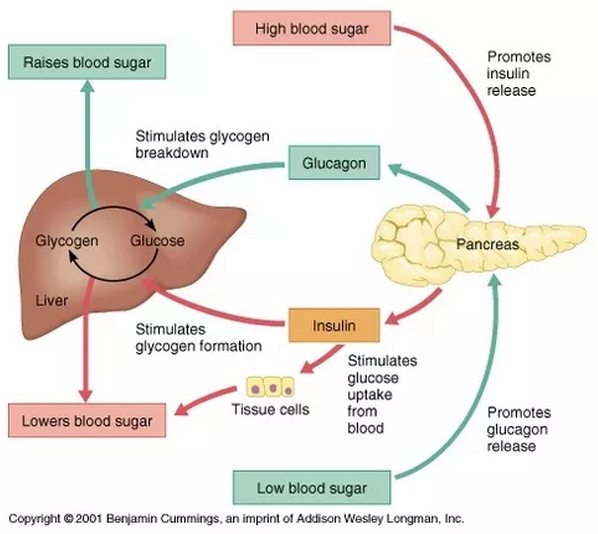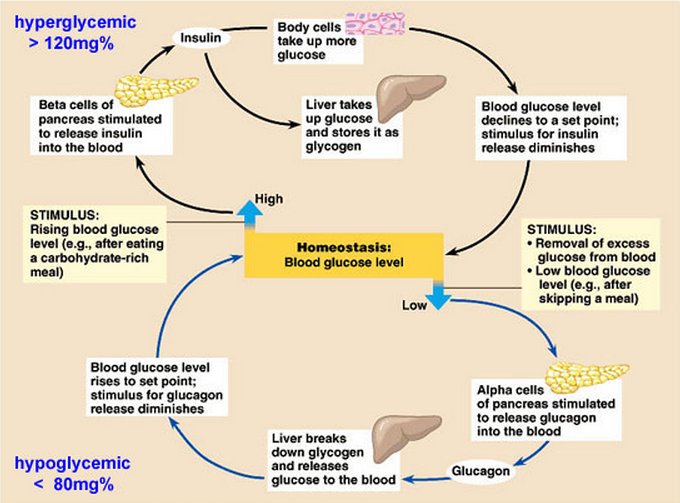Biology
 The blood glucose concentration is regulated by negative feedback control mechanisms.
The blood glucose concentration is regulated by negative feedback control mechanisms.
Blood glucose concentration should remain at a fairly constant value of about 100 mg glucose per 100 cm3 of blood.
Both of these are small proteins. They are secreted by patches of tissue called islets of Langerhans in the pancreas. Insulin is secreted by ? cells. Glucagon is secreted by ? cells.


After eating a meal, blood glucose rises:
? Food eg. starch are hydrolyzed by digestive enzymes into glucose
? Glucose is absorbed across the gut wall into the blood capillaries
? Rise in blood glucose detected by ?-cells of islets of langerhans in the pancreas
? Insulin is secreted into the bloodstream
? Promotes the uptake of glucose by the liver and muscle cells
? Glucose then converted to glycogen
During exercise, blood glucose concentration falls:
? Detected by ?- and ?-cells of islets of langerhans in the pancreas
? Fall inhibits further insulin secretion
? Secretion of glucagons by ?-cells into the blood
? Binds to receptors on liver cell surface membrane
? Activation of phosphorylase
? Promotes conversion of glycogen to glucose in the liver (glycogenolysis)
? Promotes gluconeogenesis, the production of glucose
? Glucose is released into the bloodstream
? Fats are broken down and respired.
VIDEO
- #112 Osmoregulation
Osmoregulation is the control of the water content of body fluids. It is part of homeostasis, the maintenance of a constant internal environment. It is important that cells are surrounded by tissue fluid of a similar water potential to their own...
- #111 Production Of Urine In A Nephron - Ultrafiltration And Reabsorption
Ultrafiltration occurs at the barrier between the blood and the filtrate in the renal capsule or Bowman's capsule in the kidneys. Ultrafiltration The Bowman's capsule contains a dense capillary network called the glomerulus. Blood...
- #110 Excretion And Structure Of Kidneys
The kidneys remove wastes from the blood and are the effectors for controlling the water potential of the blood. The removal of waste products generated by metabolic reactions inside body cells is called Excretion. Some of these products are toxic,...
- #109 Thermoregulation - The Control Of Body Temperature
One of the most important examples of homeostasis is the regulation of body temperature. It involves both coordination systems - nervous and endocrine. Not all animals can do this physiologically. Endotherms - Animals (e.g. birds and mammals)...
- #108 Homeostasis In Mammals
In the body of an animal conditions such as water concentration, temperature, and glucose concentration must be kept as constant as possible. Control systems that keep such conditions constant are examples of homeostasis; this is the maintenance of constant...
Biology
#113 The control of blood glucose

Blood glucose concentration should remain at a fairly constant value of about 100 mg glucose per 100 cm3 of blood.
- If blood glucose concentration falls well below this level, the person is said to be hypoglycaemic. Cells do not have enough glucose to carry out respiration, and so metabolic reactions may not be able to take place and the cells cannot function normally. This is especially so for cells such as brain cells, which can only use glucose and not other respiratory substrates. The person may become unconscious and various tissues can be damaged.
- If blood glucose concentration rises well above this level, the person is said to be hyperglycaemic. The high glucose concentration decreases the water potential of the blood and tissue fluid, so that water moves out of cells down a water potential gradient. Again, unconsciousness can result.
Both of these are small proteins. They are secreted by patches of tissue called islets of Langerhans in the pancreas. Insulin is secreted by ? cells. Glucagon is secreted by ? cells.

When blood glucose concentration rises too high, this is sensed by the ? cells. They respond by secreting greater quantities of insulin into the blood. The insulin has several effects, including:
- causing muscle and adipose tissue cells (fat cells) to absorb more glucose from the blood;
- causing liver cells to convert glucose to glycogen for storage.
- These effects cause the blood glucose concentration to fall.
- causing liver cells to break down glycogen to glucose, and releasing it into the blood;
- causing liver cells to produce glucose from other substances such as amino acids or lipids.
These effects cause blood glucose concentration to rise.

Summary:
? Food eg. starch are hydrolyzed by digestive enzymes into glucose
? Glucose is absorbed across the gut wall into the blood capillaries
? Rise in blood glucose detected by ?-cells of islets of langerhans in the pancreas
? Insulin is secreted into the bloodstream
? Promotes the uptake of glucose by the liver and muscle cells
? Glucose then converted to glycogen
During exercise, blood glucose concentration falls:
? Detected by ?- and ?-cells of islets of langerhans in the pancreas
? Fall inhibits further insulin secretion
? Secretion of glucagons by ?-cells into the blood
? Binds to receptors on liver cell surface membrane
? Activation of phosphorylase
? Promotes conversion of glycogen to glucose in the liver (glycogenolysis)
? Promotes gluconeogenesis, the production of glucose
? Glucose is released into the bloodstream
? Fats are broken down and respired.
 |
| Source: Pearson Education. |
VIDEO
Regulation of Blood Glucose
Insulin and Glucagon
Insulin and Regulation of Glucose in the Blood
Homeostasis in mammals requires complex systems to maintain internal conditions near constant. The kidneys remove wastes from the blood and are the effectors for controlling the water potential of the blood. a) discuss the importance of homeostasis in mammals and explain the principles of homeostasis in terms of internal and external stimuli, receptors, central control, co-ordination systems, effectors (muscles and glands) b) define the term negative feedback and explain how it is involved in homeostatic mechanisms c) outline the roles of the nervous system and endocrine system in co-ordinating homeostatic mechanisms, including thermoregulation, osmoregulation and the control of blood glucose concentration d) describe the deamination of amino acids and outline the formation of urea in the urea cycle (biochemical detail of the urea cycle is not required) e) describe the gross structure of the kidney and the detailed structure of the nephron with its associated blood vessels using photomicrographs and electron micrographs f) describe how the processes of ultrafiltration and selective reabsorption are involved with the formation of urine in the nephron g) describe the roles of the hypothalamus, posterior pituitary, ADH and collecting ducts in osmoregulation h) explain how the blood glucose concentration is regulated by negative feedback control mechanisms, with reference to insulin and glucagon i) outline the role of cyclic AMP as a second messenger with reference to the stimulation of liver cells by adrenaline and glucagon j) describe the three main stages of cell signalling in the control of blood glucose by adrenaline as follows: ? hormone-receptor interaction at the cell surface ? formation of cyclic AMP which binds to kinase proteins ? an enzyme cascade involving activation of enzymes by phosphorylation to amplify the signal k) explain the principles of operation of dip sticks containing glucose oxidase and peroxidase enzymes, and biosensors that can be used for quantitative measurements of glucose in blood and urine l) explain how urine analysis is used in diagnosis with reference to glucose, protein and ketones |
- #112 Osmoregulation
Osmoregulation is the control of the water content of body fluids. It is part of homeostasis, the maintenance of a constant internal environment. It is important that cells are surrounded by tissue fluid of a similar water potential to their own...
- #111 Production Of Urine In A Nephron - Ultrafiltration And Reabsorption
Ultrafiltration occurs at the barrier between the blood and the filtrate in the renal capsule or Bowman's capsule in the kidneys. Ultrafiltration The Bowman's capsule contains a dense capillary network called the glomerulus. Blood...
- #110 Excretion And Structure Of Kidneys
The kidneys remove wastes from the blood and are the effectors for controlling the water potential of the blood. The removal of waste products generated by metabolic reactions inside body cells is called Excretion. Some of these products are toxic,...
- #109 Thermoregulation - The Control Of Body Temperature
One of the most important examples of homeostasis is the regulation of body temperature. It involves both coordination systems - nervous and endocrine. Not all animals can do this physiologically. Endotherms - Animals (e.g. birds and mammals)...
- #108 Homeostasis In Mammals
In the body of an animal conditions such as water concentration, temperature, and glucose concentration must be kept as constant as possible. Control systems that keep such conditions constant are examples of homeostasis; this is the maintenance of constant...
